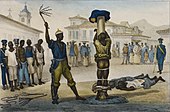| Part of a series on |
| Corporal punishment |
|---|
 |
| By place |
| By implementation |
| By country |
| Court cases |
| Politics |
| Campaigns against corporal punishment |
A knout /ˈnaʊt/ (Russian: кнут, Russian pronunciation: [knut]) is a Russian whip, that consists of rawhide thong or a rope attached to a long wooden handle; construction varies. Commonly used for prodding horses or cattle, flagellation by a knout has become notorious as a means of corporal punishment in Russian history. The English word stems from a spelling-pronunciation of a French transliteration of the Russian word кнут (knut), which simply means "whip".
Origin[edit]

Some claim[who?] it was a Tatar invention and was introduced into Russia in the 15th century, perhaps by Grand Duke Ivan III the Great (1462–1505). Others[who?] trace the word to Varangians and derive it from the Swedish knutpiska, a kind of whip with knots. Still others[who?] maintain it is of generic Germanic origin, not necessarily Scandinavian, comparing it with the German Knute, Dutch knoet (both meaning knout) and with Old Norse knutr, Anglo-Saxon cnotta and English knot.
Knout for corporal punishment[edit]
Russian executioner's knouts had different forms. One was a lash of rawhide, 40 cm (16 in) long, attached to a wooden handle, 22 cm (8.7 in) long. The lash ended in a metal ring, to which was attached a second lash as long, ending also in a ring, to which in turn was attached a few inches of hard leather ending in a beak-like hook.[1] Another kind consisted of many thongs of skin plaited and interwoven with wire, ending in loose wired ends, like the cat-o-nine tails.


A variation, known as the great knout, consisted of a handle about 60 cm (24 in) long, to which was fastened a flat leather thong about twice the length of the handle, terminating with a large copper or brass ring to which was affixed a strip of hide about 5 cm (2 in) broad at the ring, and terminating at the end of 60 cm (24 in) in a point. This was soaked in milk and dried in the sun to make it harder.
Knouts were used in Russia for flogging as formal corporal punishment of criminals and political offenders. The victim was tied to a post or on a triangle of wood and stripped, receiving the specified number of strokes on the back. A sentence of 100 or 120 lashes was equivalent to a death sentence. Even twenty lashes could maim, and with the specially extended Great Knout, twenty blows could kill, with death sometimes being attributed to the breaking of the spine.
Emperor Nicholas I abolished the punishment by knout in 1845, after years of deliberation and replaced it with the pleti,[1] a lighter whip, commonly with three tails, which was used previously for punishment as well.[2]
See also[edit]
References[edit]
- ^ a b . Brockhaus and Efron Encyclopedic Dictionary (in Russian). 1906.
- ^ . Brockhaus and Efron Encyclopedic Dictionary (in Russian). 1906.
- This article incorporates text from a publication now in the public domain: Chisholm, Hugh, ed. (1911). "Knout". Encyclopædia Britannica (11th ed.). Cambridge University Press.
External links[edit]
 The dictionary definition of knout at Wiktionary
The dictionary definition of knout at Wiktionary